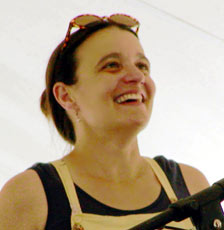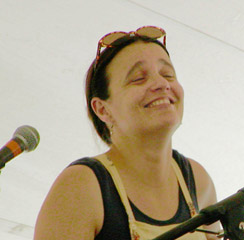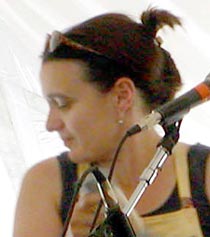 |
OCTOBER 2003
VOLUME 5 ISSUE 5
photos by Richard Cucarro
|
|
|
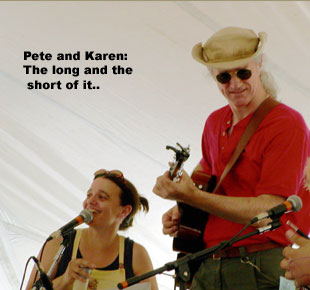
 by Richard Cuccaro
by Richard Cuccaro
The voice slices through the heavy summer heat, shape-shifting and morphing into an astonishing variety of forms. At one point it's like a little girl's voice singing happy birthday to her daddy. Then it's a wind tunnel spinning gravel whirling in mid-air. Then it becomes the voice of an old bluesman growling his way through a gospel screamer.
We're at the annual Summerfest Folk Festival in New Bedford, Massachusetts, sitting in the sparse shade of a tree just to the left of the "Musicians' Street Theater" - a canopy at the corner of Johnny Cake Hill and Union Street. Karen Savoca's bird-in-flight vocals soar and swoop. She'll occasionally engage in sly, sexual references. As her voice dips into a low rasp, it scrapes the veneer off of our subconscious, and leads us to indulge in some pleasures of the id. Karen admits she isn't dressed to let people behind her enjoy her shaking her backside to the music, as she certainly does. Pete Heitzman, master of "funk 'n folk" guitar has been shaking his, and it's duly noted by the male m.c./commentator. Karen wonders aloud about this and feigns concern. The street audience grows. Larger and larger clusters of people surround the canopy as Karen and Pete keep winning converts. She plays conga and shaker and she sings while Pete plays the funkiest guitar ever heard in folk circles. The description in the Summerfest program reads that Pete "plucks, bends and 'thaws' guitar and six-string bass." Actually, "thaw" might not be a bad term to use. If a guitar, as an inanimate object, could be thought of as frozen, Pete could certainly thaw it.
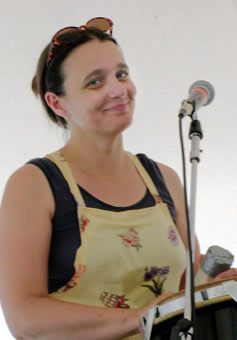 Pete struggles a bit with some static-y problem with his pickup and says "it's always a 25 cent part!" Prefacing a song to the recently departed Katherine Hepburn, Karen says that the actress once ended a graduation commencement speach with: "Life's gonna try and knock you down; just don't let it knock you up!" Singing now, Karen trills with her tongue and invites the audience to jump in with any crazy sounds. Somebody yells yah- yah- yah- yah! Karen responds, "C'mon, c'mon, let it out," as the music chugs and thumps. Her yodeling eclipses anything the audience can offer and they break into spontaneous applause and gasps of astonishment. That melodic rasp boggles minds and they rush off to buy her CDs.
Pete struggles a bit with some static-y problem with his pickup and says "it's always a 25 cent part!" Prefacing a song to the recently departed Katherine Hepburn, Karen says that the actress once ended a graduation commencement speach with: "Life's gonna try and knock you down; just don't let it knock you up!" Singing now, Karen trills with her tongue and invites the audience to jump in with any crazy sounds. Somebody yells yah- yah- yah- yah! Karen responds, "C'mon, c'mon, let it out," as the music chugs and thumps. Her yodeling eclipses anything the audience can offer and they break into spontaneous applause and gasps of astonishment. That melodic rasp boggles minds and they rush off to buy her CDs.
Later, at a workshop in the Whaling Theater, their duet is sinuous, like two skaters gliding across ice. Karen sings in her signature sighing rasp while Pete's guitar effects sound like there should be a whole raft of pedals at his feet. Playing near the bridge, he wrings notes that are metallically sharp and then, moving towrd the sound hole, some that are bass-like that resonate in the cavity of your stomach and chest. One of the most popular songs in their repertoire "You Just Don't Get it," is dedicated here to George W. Bush and, as in any other folk setting, meets with sweeping audience approval. Then, Karen introduces a new song while Pete, his long gray ponytail hanging from under the back of his Australian Bushman's hat, plays out a funky bass line in the background. In an instrumental bridge, Pete's guitar snarls through a small amp.When he straps on the Daneloectro six string bass, the snarling notes he wrings out seem to pull Memphis all the way to Massachusetts.
Early On As we learn from the bio on their web site, Karen Savoca's mom was the featured vocalist on a nightly TV show in Fresno, California. Later, She chose marriage and motherhood over a singing career. Karen said that both she and her mom sang a lot around the house and that the record collection contained the work of many jazz singers. She remembers that her grandfather played ukelele. At the age of ten, Karen bought her first album on a whim... it was Life, by Sly and The Family Stone. When Karen was young, her family would drive from New Jersey to spend weekends at a camp in the mountains of upstate New York. Both parents loved being out in the country. When she was thirteen they decided they'd rather spend all their time there, so they built a log home on a mountain in the town of Cobleskill. Although she wanted to play the drums, she got piano lessons instead. Since dad was a sports nut and the piano was next to the TV, during football games, she'd jump up to play during commercials and half-times. Around this time, she bought herself her first guitar. The solitude of the country gave her plenty of time to immerse herself in music, playing and composing. During this period she was also performing at school, county fairs and coffeehouses.
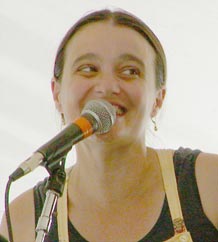 After high school, she attended Crouse College at Syracuse University to study music. Karen found that the operatic and restrictive nature of the program was not for her. She switched her major to Elementary Ed, telling the school administrators that she'd be using her music training in the classroom so as not to lose her credits. During that time she honed her singing style with several groups on campus and around town.
After high school, she attended Crouse College at Syracuse University to study music. Karen found that the operatic and restrictive nature of the program was not for her. She switched her major to Elementary Ed, telling the school administrators that she'd be using her music training in the classroom so as not to lose her credits. During that time she honed her singing style with several groups on campus and around town.
While she was the lead singer with a group, Pete Heitzman's mom came to listen and told Karen after one show that her son was a great guitar player and she'd bring him by one night to hear her. Karen thought that the woman was pretty hip, coming out to hear the band, along with a much younger crowd, but was skeptical, having heard this sort of thing a few times before. However, one of the band members was an old friend of Pete's and he finally came by a couple of months later. He'd been living in Atlanta, and was just visiting at home. He jammed with Karen and the group that night and it effectively ended his southern residency. He returned to Atlanta the next day and packed his things, went back home and joined the group.
Pete's Journey Pete's mom, a music lover, saw to it that they had a nice stereo early on. He remembers a demo LP that exaggerated the stereo and "you'd feel like you were being tossed from side to side like a carnival ride." He became aware of sound production, realizing that "you could actually record things in different ways." Using a Webcor tape recorder, the Heitzman offspring would record off Top 40 radio, and produce their own comedy skits and do mockup rewrites of maudlin doo wop songs. Pete loved the pop folk of the time... Peter Paul & Mary, The Kingston Trio and Burl Ives. He says, though, "What made me want to play guitar was The Beatles, specifically, the track 'I Feel Fine'. That guitar tone still devastates me." His parents bought him "a nice Gretsch" on the condition that he take formal instruction, But he'd sit down to practice the lesson and recognize a chord from "a Buffalo Springfield or Moby Grape song I'd been working on, and I'd spend the rest of the day messing with that." He says that, "I knew I was hard core when, in eighth grade, I replaced my best friend with a better, more dedicated drummer. It was cold, but I couldn't help it!" His favorites were rock players like Beck, Clapton, Peter Green, Clarence White and Jimi Hendrix. "Then," he says "those players pointed us to the blues masters, B.B.King, Albert King, Buddy Guy, and Muddy Waters. He adds. "I also listened to a lot of Miles, Django, Wes Montgomery, Burt Bacharach, Bach, Mozart, Doc Watson... I've never been very focused on any one style for long."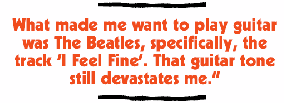
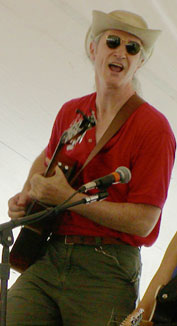 Evolution The following statement may be the perfect description of the evolution of a guitar player: "I spent most of my teen years playing to records down in my basement bedroom. I would 'become' Mike Bloomfield for 6 months, for example, then move on to absorb another player. I'd blindfold myself and play for hours. I'd learn the chords, bass parts and leads, note for note, tone for tone... as best I could at any rate. It was good ear training and as a result I'm comfortable in a variety of musical situations. But improvising over blues particularly was an absolute revelation. Liberating. I could express every emotion I'd ever felt. I think everything I play is probably based on blues."
Evolution The following statement may be the perfect description of the evolution of a guitar player: "I spent most of my teen years playing to records down in my basement bedroom. I would 'become' Mike Bloomfield for 6 months, for example, then move on to absorb another player. I'd blindfold myself and play for hours. I'd learn the chords, bass parts and leads, note for note, tone for tone... as best I could at any rate. It was good ear training and as a result I'm comfortable in a variety of musical situations. But improvising over blues particularly was an absolute revelation. Liberating. I could express every emotion I'd ever felt. I think everything I play is probably based on blues."
When I asked about the influence of other musicians, his answer was revealing and enlightening: "Meeting Karen changed to way I approach music. I'm now much more focused on the song, and less on the guitar. Now I get more excited about good arrangements that really compliment the voice. At one point it occurred to me that there are only two instruments, voice & drum, and everything else is a variation of these two. I've always approached the guitar as a voice, so I began to work more on rhythm. Karen has helped me a lot. Her time is like a rock, and she always grooves. Working with her has also made me learn to play at slower tempos, which are much more challenging to make it swing. As for more specific influences on my playing, many African string players knock me out. Their sense of time is so sophisticated compared with the hum-drum back beat of western pop. It makes me feel like the ground is slipping out from beneath me, yet the pulse is right there. Your body has to move to it. I love music that pushes and pulls, and I think drum machines should be outlawed."
When I asked him how he knew he'd make music for a living, he answered, "After high school, I played in bands for two years. But by 1973, so many venues had replaced live bands with disco systems that I felt the future of live music was pretty iffy, so I studied English Lit & Experimental Psych. What's weird is that even though I played very little guitar in that period, I constantly heard Django style improvs in my head... incessantly. I was a junior at Colgate, and had been feeling inexplicably anxious for months. I finally reached for my Strat and within 5 minutes I was completely cured! That's when I knew I was doomed to be a musician."
Moving On Karen and Pete kept finding themselves wanting to experiment with their own style outside the confines of the group and began performing gigs on their own. They finally left and decided to try the creative environment of New York City. This lasted four years. They gigged, worked strange temp jobs, wrote songs, and saved enough to assemble a recording studio. This proved to be more difficult than the rewards it offered, so they returned to upstate New York, where they could afford to do nothing but make music. Back home, they formed "The Mind's Eye," an all original, improvisation-laced band with the best jazz and funk players in the area. The band played every Monday for seven years at The Orange Grove, a bar just off the Syracuse University campus. With the band, Karen played a Hohner Clavinet, lots of hand percussion, and finally got herself a conga drum. Their audience danced and improvised as well, call and response style, sometimes developing elaborate counterpuntal routines. Known as Grovers, Karen and Pete encounter these SU grads wherever they tour.
The Greg Factor A recent development has been their collaboration with Greg Brown. They saw him perform for the first time at Falcon Ridge Folk Festival. Having spent many years on the rock circuit, they were still getting acquainted with national folk acts. They sat in the audience and were blown away. They asked themselves,"How can we not known about this guy?" They finally met Greg at The Eighth Step in Albany New York, where they opened for him. Greg stood in the back of the room and listened to their entire set. It made Karen nervous, but she thought, "Well, he must like it or he wouln't be standing there listening." She approached him in the green room and told him how much she loved his music. "The next thing I knew, he was calling us up to play his encores with him," she related. He then suggested that they come out on the road with him as openers. Since they both had the same booking agent at the time, it was easy to work out. Soon, on occasion Greg was using them as his band as well, and this is where things stand at the moment. They've collaborated on several CDs, including Greg's Milk Of The Moon and the recent joint effort, Live At The Black Sheep. Karen also recorded a song for Going Driftless, a Women's Tribute to Greg Brown, on Red House Records. Karen feels that he's had a wonderful influence on her own writing and cites his amazing versatility in writing in different styles and his way of putting rhymes in unexpected places or using near-rhymes. "It's been really dreamy," she says. "Dreamy" might also apply to their one-two combination of vocal aeronautics and fiery funk.
Their CD output on Alcove Records:
(1988) ~ Walkin' The Bridge
(1993) ~ On The River Road
(1998) ~ Sunday In Nandua
(1999) ~ Here We Go
(2002) ~ All My Excuses
(2002) ~ Milk Of The Moon (Red House) by Greg Brown- was produced, recorded and mixed at Alcove Sound by Pete Heitzman & Karen Savoca
(2003) ~ Live At The Black Sheep with Greg Brown & Garnet Rogers
Compilations:
(2002) ~ Going Driftless (Red House) a Women's Tribute to Greg Brown
(2003) ~ Where We Live (Higher Octave) ~ to benefit Earth Justice
Booking Info: Alcove Records:info@alcoverecords.com
To purchase CDs, check the website at: www.karensavoca.com



 Pete struggles a bit with some static-y problem with his pickup and says "it's always a 25 cent part!" Prefacing a song to the recently departed Katherine Hepburn, Karen says that the actress once ended a graduation commencement speach with: "Life's gonna try and knock you down; just don't let it knock you up!" Singing now, Karen trills with her tongue and invites the audience to jump in with any crazy sounds. Somebody yells yah- yah- yah- yah! Karen responds, "C'mon, c'mon, let it out," as the music chugs and thumps. Her yodeling eclipses anything the audience can offer and they break into spontaneous applause and gasps of astonishment. That melodic rasp boggles minds and they rush off to buy her CDs.
Pete struggles a bit with some static-y problem with his pickup and says "it's always a 25 cent part!" Prefacing a song to the recently departed Katherine Hepburn, Karen says that the actress once ended a graduation commencement speach with: "Life's gonna try and knock you down; just don't let it knock you up!" Singing now, Karen trills with her tongue and invites the audience to jump in with any crazy sounds. Somebody yells yah- yah- yah- yah! Karen responds, "C'mon, c'mon, let it out," as the music chugs and thumps. Her yodeling eclipses anything the audience can offer and they break into spontaneous applause and gasps of astonishment. That melodic rasp boggles minds and they rush off to buy her CDs. After high school, she attended Crouse College at Syracuse University to study music. Karen found that the operatic and restrictive nature of the program was not for her. She switched her major to Elementary Ed, telling the school administrators that she'd be using her music training in the classroom so as not to lose her credits. During that time she honed her singing style with several groups on campus and around town.
After high school, she attended Crouse College at Syracuse University to study music. Karen found that the operatic and restrictive nature of the program was not for her. She switched her major to Elementary Ed, telling the school administrators that she'd be using her music training in the classroom so as not to lose her credits. During that time she honed her singing style with several groups on campus and around town.
 Evolution The following statement may be the perfect description of the evolution of a guitar player: "I spent most of my teen years playing to records down in my basement bedroom. I would 'become' Mike Bloomfield for 6 months, for example, then move on to absorb another player. I'd blindfold myself and play for hours. I'd learn the chords, bass parts and leads, note for note, tone for tone... as best I could at any rate. It was good ear training and as a result I'm comfortable in a variety of musical situations. But improvising over blues particularly was an absolute revelation. Liberating. I could express every emotion I'd ever felt. I think everything I play is probably based on blues."
Evolution The following statement may be the perfect description of the evolution of a guitar player: "I spent most of my teen years playing to records down in my basement bedroom. I would 'become' Mike Bloomfield for 6 months, for example, then move on to absorb another player. I'd blindfold myself and play for hours. I'd learn the chords, bass parts and leads, note for note, tone for tone... as best I could at any rate. It was good ear training and as a result I'm comfortable in a variety of musical situations. But improvising over blues particularly was an absolute revelation. Liberating. I could express every emotion I'd ever felt. I think everything I play is probably based on blues."